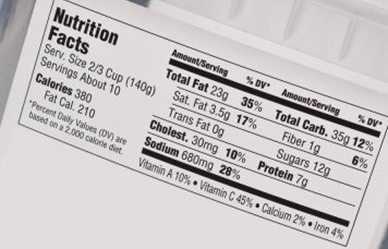Reading Food Labels
Reading food labels is one of the most effective ways of determining the right kind of food to buy in the supermarket. It lets you make sensible food selections. The food label includes valuable information, especially to a diabetic.
Admittedly, reading food labels can be very tedious and confusing. Nevertheless, once you get the hang of it, it will be easier for you to maintain healthy food choices by knowing what’s really in the foods you are purchasing and consuming.
The ingredient list
This is a good place to start before looking at the numbers on the food label. Ingredients are listed in order of quantity to the entire product.
If sugar is listed first, there is more sugar in that product than anything else. The closer it is to the beginning of the list the more of it is present in the food. Unfortunately, sugar has so many different names – many of the chemical – that you might see 4 types of sugar listed further down the label, some chemical names. Add them up and sugar could be the largest ingredient in the product.
Avoid foods that list items that don’t work well for you. Allergic to rosemary? Check the label to see if it’s listed. Products with a lot of unpronounceable chemical ingredients should also be avoided.
Look at the serving size and compare that to the number of carbohydrates is in a serving. Diabetic serving size for carbohydrates is usually 15 grams. If one serving is higher than 15 grams, you’ll have to eat less than the suggested serving size to stay on track with your meal plan.
Sugar-free foods
These may grab your attention as something safe and yummy to add to your shopping cart. But look at the carbohydrate and fat counts first. Most foods that are sugar-free use artificial sweeteners and sugar substitutes, but have higher carbohydrates or fats added. There are always tradeoffs to make the foods tasty.
Check the fat content.
Unless you are on a very controlled keto diet, look for a small number of fat grams. Protein, carbohydrates, and fats are listed in grams. However, protein and carbs have 4 calories per gram in the calorie count. Fat, on the other hand, has 9. More than double the protein and carbs. So, the total calories from fat could be much higher than expected. As a percentage of the product, it could easily be over 50% of the total calories.
Back in the 70’s, the government declared war on fats (like Arnold Schwarzenegger said in True Lies, “they were all bad”). So, the food manufacturers decreased fats and increased sugars and carbs for flavor. And the swelling of America happened.
Fortunately, now the tables are turning. It’s been scientifically proven that fats aren’t all bad. But you need to know what kind of fats you’re eating. Trans fats should be avoided. Some saturated fats are fine – coconut and avocado for example. All fats have the same 9 calories per gram, but they react differently in your body.
Through the “Nutrition Facts” section of the label, you can identify the serving sizes and number of servings. Remember to take into consideration how much you eat as a single serving.
The amounts and kinds of nutrients are included in the label. Usually, the label contains the information on saturated fat, sodium, total fat, fiber, and cholesterol amount “per serving.”
Things you need to know
Serving size
As already stated, the amount of servings on the label refers to the quantity of food the manufacturers determine people “usually” consume. Food manufacturers may use this to trick the casual observer into thinking there are fewer calories, fats, and carbs in the product.
The manufacturer cleverly shows acceptable amounts but increases the number of servings. If you typically consume an entire package of mac and cheese in one sitting, you need to multiply the number of servings by the grams/calories shown to get the real amounts and their effect on your body. You may be stunned at how many calories, fat grams, and carbs you’re eating.
We live in a supersized world
A restaurant’s “single serving” is usually about two or three at-home servings. We’re used to larger quantities without even thinking that it means more calories.
Nutrients
This refers to the list of available nutrients in the food product. The percentages are based on the government’s recommended daily dietary allowance, usually an arbitrary 2,000 calories. However, if you have a very small frame and can only burn 1,500 calories/day, you might need to recalculate the percentages.
Ingredients
This refers to the list of the ingredients that were used to manufacture the product, arranged from the greatest amount by weight to the smallest quantity. Occasionally some ingredients are listed as “other spices,” for example, in unknown amounts, which usually means a very small quantity.
Label claim
This refers to the kinds of nutritional claims of the food item. For instance, if the label says it’s sodium-free, it should have less than 5 milligrams per serving, or a low-fat item should contain 3 grams of fat or less.
In looking at carbohydrates, the label should show total carbs and fiber. If you subtract the fiber grams from the total carbs, you will have net carbs. Since fiber is non-digestible, some diet plans count only the net carbs.
Happy label reading! Just be prepared to put things back on the shelves.

